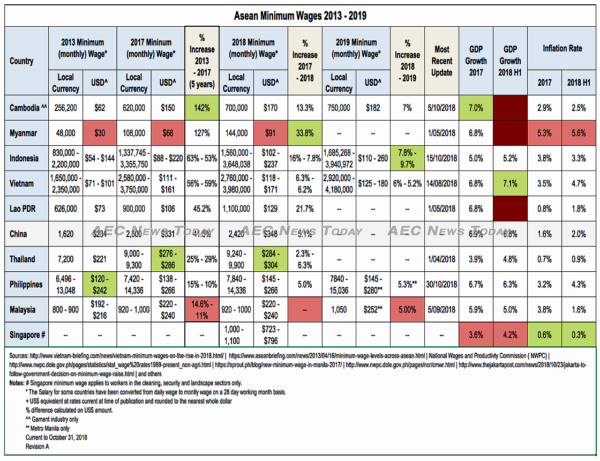A Philippine labour group which last Thursday slammed a proposed PHP20 (about US$0.37) daily minimum wage increase for workers in Metro Manila as “demeaning” and out of step with rising inflation, yesterday called for Philippine President Rodrigo Duterte to intercede.
The call came after Employees Confederation of the Philippines (ECoP) acting presiden,t Sergio R. Ortiz-Luis, Jr., announced on Tuesday that the Regional Tripartite Wages and Productivity Board for the NCR (RTWPB-NCR) had agreed on a PHP25 ($0.47) daily minimum wage increase for workers in the National Capital Region (NCR).
The amount is well below the PHP334, or $6.24 per day that the Associated Labor Unions-Trade Union Congress of the Philippines (ALU-TUCP) — the country’s largest labour organisation — has been lobbying the RTWPB-NCR for and which it says is needed to offset the cost of rising consumer prices.
Describing the PHP25 ($0.47) increase as a “measly token”, ALU-TUCP spokesperson Alan A. Tanjusay said Wednesday that the proposed amount falls far short of addressing the lost value of National Capital Region wages in the face of the spiralling prices of basic goods. In September inflation reached a nine-year high of 6.7 per cent.
Accusing the employers behind the offer as insulting the four million wage earners in Metro Manila, Mr Tanjusay said “such a measly wage increase won’t uplift millions of minimum waged workers in Metro Manila who now live below poverty.
“We are not asking for a lavish and extravagant wage increase. We are just demanding a survival wage hike to recover the lost value of our wages so that we can cope with rising inflation and avoid hunger”, he added.
ECOP, however, has been cautioning against a substantial pay increase, saying such a move would only push consumer prices higher and could force businesses to close at the cost of thousands of lost jobs. It also warned against inflation-based wage increases.
“If we increase the wages and the inflation rate goes down, will the wages also go down? I don’t think it is a good basis for increasing wages”, said Antonio Abad, the governor of ECOP. “There must be other factors for increasing wages”, adding, that inflation is “fluctuating and temporary in nature”.
“Measly” wage rise not a done deal

While ECOP might think the PHP25 increase is a done deal, it isn’t necessarily so. Presidential spokesperson Salvador S. Panelo said yesterday (Oct 31) that the National Wages and Productivity Commission (NWPC) had not yet reviewed the proposal, describing the PHP25 figure as “not official”.
A cost-of-living survey by a labour group in May found that a family of five in Metro Manila needed PHP1,300, or about $24, a day to lead a decent life. That would put the necessary monthly minimum wage at PHP36,400 or some $682 for a 28-day work month.
The current daily minimum wage in Metro Manila is PHP512, or about $9.55, putting the monthly total at about $286. Daily minimum wage rates in the provinces are much lower.
The plight of the NCRs most vulnerable workers and their battle for a liveable wage has not gone unnoticed.
Citing 2015 figures lawmaker Ariel Casilao said yesterday that NCR establishments had a combined profit of PHP903 billion ($16.952 bln), but only paid their workers an average of PHP530 ($9.95) [per day].
“Raising the minimum wage in NCR to PHP750 ($14.08) will cost PHP133 billion ($2,497 bln), or just 14.6 per cent of their profits”, he said.
The Department of Labor and Employment (Dole) said late yesterday that a formal announcement on the wage adjustment for Metro Manila will be made next Monday (Nov 5).
In the meantime, a commuter group’s appeal against a recent PHP10 ($0.19) increase in the cost of jeepney fares in the NCR, Region 3, and Region 4 has been denied. Pending further challenges commuters will have to pay the increased fares, with the increase in one trip alone representing 40 per cent of the daily minimum wage increase proposed by employers.
Tracking Asean minimum wages

The dispute in Manila reflects a trend across Asean, where wages have been rising over the last five years. However, while wage growth has been spectacular in some countries, rampaging inflation and poor fact-based, impartial review mechanisms have seen some workers today worse off than in the past.
While costs have increased, the buying power of monthly pay packets has shrunk. The claims of Mr Tanjusay are not mere union hyperbole aimed at leveraging a larger increase.
Once among the regions best paid workers, the minimum wage for Filipinos in 2018 is less than what was stipulated for Thais in 2017, whose wages grew by between 25 and 29 per cent in the five years prior. In comparison minimum wages in the Philippines grew by just 10 – 15 per cent over the same period. The higher growth occurring at the lower end of the minimum wage spectrum. Even still, the lowest paid worker in the Philippines still earns less than the lowest paid Thai or Malaysian did in 2013.
Malaysian workers have similarly experienced weak wage growth over the past six years, not seeing any increase between 2017 and 2018 and being granted an increase of just 5 per cent for 2019.
Myanmar, Cambodia lead Asean wage growth
It’s not all bad news for Asean workers. While the region’s traditionally lowest paid workers remain so, in recent years some have seen wage growth well in excess of inflation or national GDP.
For the fastest wage growth in the region between 2013 and 2017 one has only to look at Cambodia where the minimum wage increased by 142 per cent between 2013 and 2017.
However, with elections out of the way for another five years Cambodia minimum wage workers will only see a modest 7 per cent increase in their pay packets next year, almost half of the 13.3 per cent increase they saw this year.

Similarly enjoying robust minimum wage growth have been workers in Myanmar. Between 2013 and 2017 minimum wages there increased 127 per cent, with a workers getting a further 33.8 per cent increase in minimum wages between last year and this. A wage increase for 2019 has not been announced yet.
Whereas in 2013 the minimum wage of a Cambodian worker was a little over half that of a Filipino worker, today the situation is reversed. The Cambodian garment sector worker earns 17 per cent more than the lowest paid Filipino, with consumer prices and inflation in Cambodia considerably more stable.
While workers in Lao PDR, Indonesia, and Vietnam have not enjoyed such meteoric minimum wage growth over the same period, workers in all three have none the less seen their fortunes increase.
How Filipinos fare in the Asean wage race will largely depend on whether Mr Duterte decides to act on Mr Tanjusay’s call. With police, teachers and military all receiving generous pay rises over the past two years, some feel it’s time the nation’s lowest paid also saw some increased prosperity.
Feature video ABS-CBN News
Update: The article was last updated on November 15 at 18:49. The table was replaced due to an error contained in the original.
John Le Fevre in Bangkok contributed to this story
Related:
- P20 minimum wage hike proposal ‘demeaning’, says labor group (ABS-CBN News)
- Metro Manila workers want P1,300 daily pay (The Philippine Star)
- Labor hits P20 wage hike offer (Philippine Daily Inquirer)
Stella-maris Ewudolu
Between November 2010 and February 2012 she was a staff writer at Daylight Online, Nigeria writing on health, fashion, and relationships. From 2010 – 2017 she worked as a freelance screen writer for ‘Nollywood’, Nigeria.
She joined AEC News Today in December 2016.
Latest posts by Stella-maris Ewudolu (see all)
- Zoonotic crossover fear sees Vietnam ban (almost) all wildlife trade (video) – July 26, 2020
- Job & revenue losses: COVID-19 to hurt Asean airlines the most – July 24, 2020
- Philippines morning news for July 24 – July 24, 2020
- Philippines morning news for July 23 – July 23, 2020

